Reflection on Water Shortage in Australia Assignment 2022
Added on 2022-10-12
24 Pages6618 Words25 Views
Reflection on Water Shortage in Australia 1
REFLECTION ON WATER SHORTAGE IN AUSTRALIA
Name
Course
Professor
University
City/state
Date
REFLECTION ON WATER SHORTAGE IN AUSTRALIA
Name
Course
Professor
University
City/state
Date
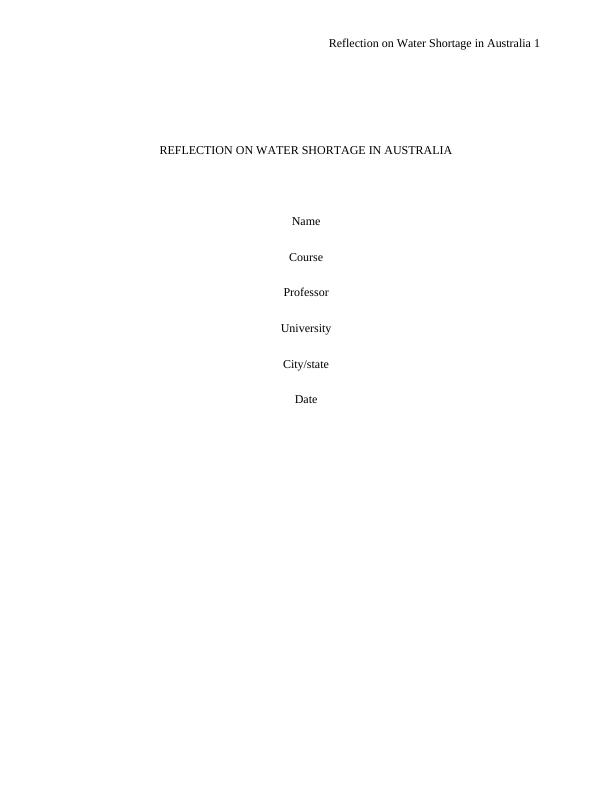
Reflection on Water Shortage in Australia 2
Table of Contents
1. Introduction............................................................................................................ 3
2. Area of focus........................................................................................................... 3
3. Climate of Australia................................................................................................. 4
4. Water shortage in Australia....................................................................................... 7
5. Causes of water shortage........................................................................................... 9
5.1. Increased human population................................................................................ 9
5.2. Urbanization................................................................................................... 10
5.3. Industrialization.............................................................................................. 11
5.4. Pollution........................................................................................................ 12
5.5. Climate change................................................................................................ 13
5.6. Wastage......................................................................................................... 13
5.7. Deforestation.................................................................................................. 14
5.8. Mismanagement of water resources.....................................................................14
6. Water shortage impacts........................................................................................... 15
7. Solutions to water supply requirements......................................................................15
7.1. Education and awareness.................................................................................. 16
7.2. Prevent pollution............................................................................................. 16
7.3. Use of greywater.............................................................................................. 17
7.4. Rainwater harvesting....................................................................................... 17
7.5. Conserve water catchment areas.........................................................................17
7.6. Use of water efficient systems and practices..........................................................18
7.7. Improve water supply systems............................................................................18
7.8. Technology and research and development (R&D).................................................18
7.9. Policies.......................................................................................................... 19
8. Conclusion............................................................................................................ 19
References............................................................................................................. 22
Table of Contents
1. Introduction............................................................................................................ 3
2. Area of focus........................................................................................................... 3
3. Climate of Australia................................................................................................. 4
4. Water shortage in Australia....................................................................................... 7
5. Causes of water shortage........................................................................................... 9
5.1. Increased human population................................................................................ 9
5.2. Urbanization................................................................................................... 10
5.3. Industrialization.............................................................................................. 11
5.4. Pollution........................................................................................................ 12
5.5. Climate change................................................................................................ 13
5.6. Wastage......................................................................................................... 13
5.7. Deforestation.................................................................................................. 14
5.8. Mismanagement of water resources.....................................................................14
6. Water shortage impacts........................................................................................... 15
7. Solutions to water supply requirements......................................................................15
7.1. Education and awareness.................................................................................. 16
7.2. Prevent pollution............................................................................................. 16
7.3. Use of greywater.............................................................................................. 17
7.4. Rainwater harvesting....................................................................................... 17
7.5. Conserve water catchment areas.........................................................................17
7.6. Use of water efficient systems and practices..........................................................18
7.7. Improve water supply systems............................................................................18
7.8. Technology and research and development (R&D).................................................18
7.9. Policies.......................................................................................................... 19
8. Conclusion............................................................................................................ 19
References............................................................................................................. 22
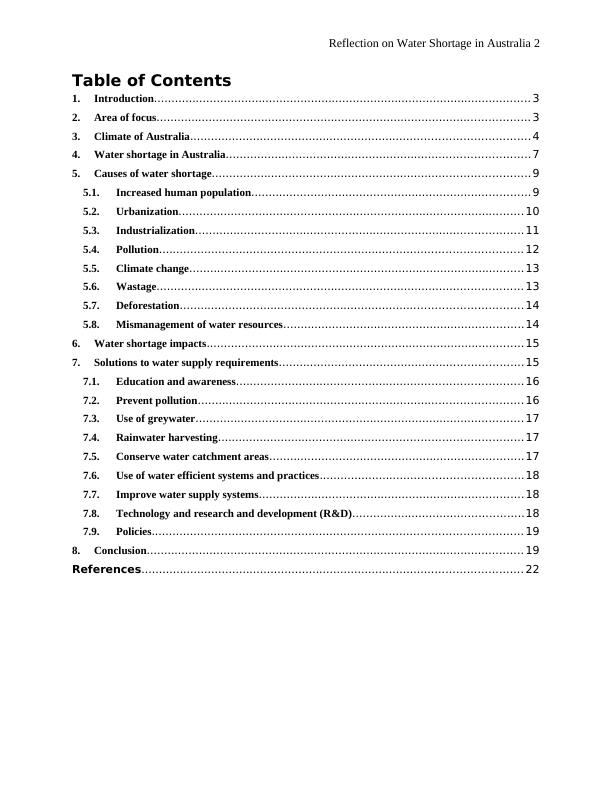
Reflection on Water Shortage in Australia 3
1. Introduction
My focus in this assignment is on the assessment of personal and self-management skills in
relation to the context of the course – global change and water shortage impacts on engineering
activities between now and 2050. These skills are very essential in engineers’ day-to-day
activities because they enhance their actions and behaviour (Steyn & van Staden, 2018), and
ethical conduct and integrity. I will complete this assignment through reflection on various
achievements I have made so far in relation to engineering competencies, personal skills,
attributes, qualities and research effectiveness. My main goal in this assignment is to
demonstrate the application of engineering competencies and skills I have acquired so far in
analyzing and solving water shortage problem in the area of focus. I will analyze the water
shortage problem in Australia so as to demonstrate the importance of engineering competencies I
have learned and acquired so far in this course.
Water is a very essential natural resource for the existence of human beings, animals and
plants. The resource, which is a basic need, is so important that there cannot be life without
water. It is estimated that 71% of the earth’s surface is covered with water (Williams, 2014).
However, only about 3% of this water is freshwater (Global Environment Facility, 2015).
This has made inadequate supply of potable water to be a global problem that should be solved
through combination of engineering solutions and administrative solutions. Approximately one-
sixth of human population (over 1 billion people) worldwide lacks access to potable water and
over two million people die annually from waterborne diseases such as typhoid, cholera and
diarrhea. By 2025, it is projected that one-third of global human population will be facing
chronic and severe water shortages (World Water Council, (n.d.)). These are life-threatening
statistics and projections that should be taken with the seriousness they deserve.
1. Introduction
My focus in this assignment is on the assessment of personal and self-management skills in
relation to the context of the course – global change and water shortage impacts on engineering
activities between now and 2050. These skills are very essential in engineers’ day-to-day
activities because they enhance their actions and behaviour (Steyn & van Staden, 2018), and
ethical conduct and integrity. I will complete this assignment through reflection on various
achievements I have made so far in relation to engineering competencies, personal skills,
attributes, qualities and research effectiveness. My main goal in this assignment is to
demonstrate the application of engineering competencies and skills I have acquired so far in
analyzing and solving water shortage problem in the area of focus. I will analyze the water
shortage problem in Australia so as to demonstrate the importance of engineering competencies I
have learned and acquired so far in this course.
Water is a very essential natural resource for the existence of human beings, animals and
plants. The resource, which is a basic need, is so important that there cannot be life without
water. It is estimated that 71% of the earth’s surface is covered with water (Williams, 2014).
However, only about 3% of this water is freshwater (Global Environment Facility, 2015).
This has made inadequate supply of potable water to be a global problem that should be solved
through combination of engineering solutions and administrative solutions. Approximately one-
sixth of human population (over 1 billion people) worldwide lacks access to potable water and
over two million people die annually from waterborne diseases such as typhoid, cholera and
diarrhea. By 2025, it is projected that one-third of global human population will be facing
chronic and severe water shortages (World Water Council, (n.d.)). These are life-threatening
statistics and projections that should be taken with the seriousness they deserve.
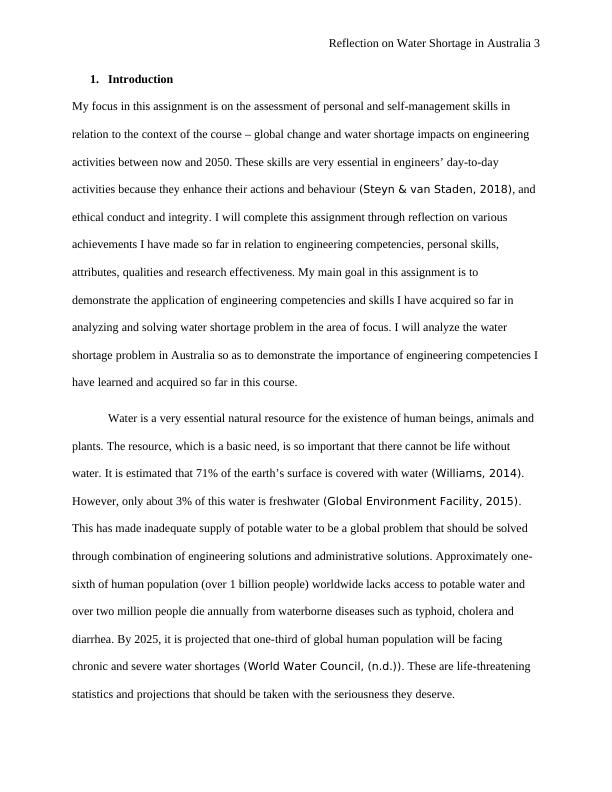
Reflection on Water Shortage in Australia 4
2. Area of focus
The interest focus I have selected for this paper is water supply in Australia. Australia is the
smallest continent on earth with an area of 7,741,220 km2 out of which 7,682,300 km2 is
occupied by land and 58,920km2 is occupied by water. This means that only 0.76% of Australia
is covered by water. The human population of Australia is approximately 25.1 million,
accounting for 0.33% of the world’s population of about 7.61 billion people. Based on these
statistics of total population, urban population and water coverage, it seems fascinating to
investigate water supply and water shortage in Australia. This investigation will provide useful
information that can be used to solve water shortage problem in Australia and other countries in
the world. Water supply is the delivery or provision of water by individuals, community
endeavors, commercial companies or public utilities to different consumers, such as households,
institutions, business premises, farms or industries. This paper focuses on provision or supply of
water by the public utilities. A typical water supply system comprises of a drainage basic, raw
water collection point, water purification or treatment facilities, water storage facilities, extra
water pressurizing components, distribution system comprising of a pipe network, and sewer
connections. These components can be categorized into: source of water supply, treatment or
processing of the water, and distribution, transportation or delivery of the water to end
consumers.
3. Climate of Australia
Based on Koppen-Geiger classification, the climate of Australia can be divided into six climate
zones: Aw climate, BSh climate, BWh climate, Cf climate, Cfb climate, Cfa climate and Csb
climate. Aw climate (savannah or tropical dry and wet climate) is experienced in the northern
coastal parts of Australia and is characterized by a hot tropical climate where temperatures
2. Area of focus
The interest focus I have selected for this paper is water supply in Australia. Australia is the
smallest continent on earth with an area of 7,741,220 km2 out of which 7,682,300 km2 is
occupied by land and 58,920km2 is occupied by water. This means that only 0.76% of Australia
is covered by water. The human population of Australia is approximately 25.1 million,
accounting for 0.33% of the world’s population of about 7.61 billion people. Based on these
statistics of total population, urban population and water coverage, it seems fascinating to
investigate water supply and water shortage in Australia. This investigation will provide useful
information that can be used to solve water shortage problem in Australia and other countries in
the world. Water supply is the delivery or provision of water by individuals, community
endeavors, commercial companies or public utilities to different consumers, such as households,
institutions, business premises, farms or industries. This paper focuses on provision or supply of
water by the public utilities. A typical water supply system comprises of a drainage basic, raw
water collection point, water purification or treatment facilities, water storage facilities, extra
water pressurizing components, distribution system comprising of a pipe network, and sewer
connections. These components can be categorized into: source of water supply, treatment or
processing of the water, and distribution, transportation or delivery of the water to end
consumers.
3. Climate of Australia
Based on Koppen-Geiger classification, the climate of Australia can be divided into six climate
zones: Aw climate, BSh climate, BWh climate, Cf climate, Cfb climate, Cfa climate and Csb
climate. Aw climate (savannah or tropical dry and wet climate) is experienced in the northern
coastal parts of Australia and is characterized by a hot tropical climate where temperatures
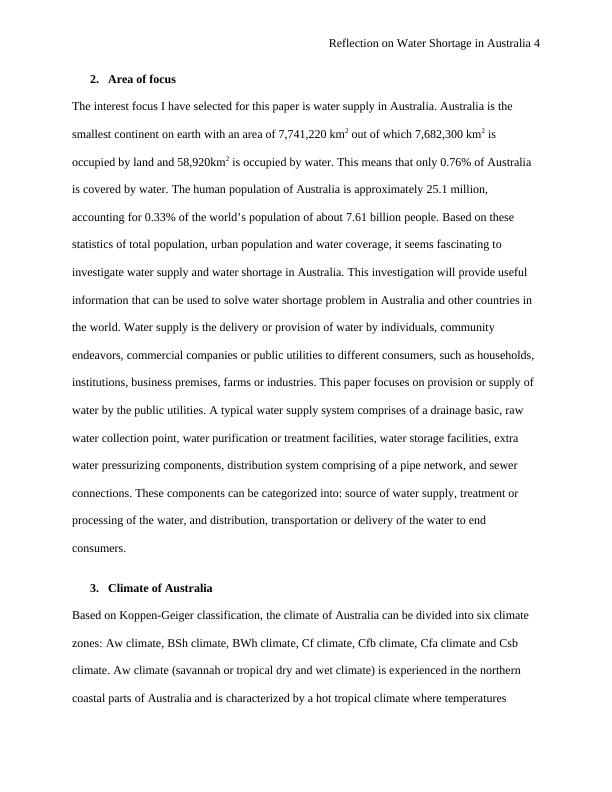
Reflection on Water Shortage in Australia 5
exceed 18°C during all months, a dry winter and driest month receiving rainfall of less than 60
mm. BSh climate (hot semi-arid climate) is experienced in more inland areas and those areas that
are close to the west coast of Australia. These areas have a dryer subtropical climate with an
annual average temperature exceeding 18°C. BWh climate (hot desert climate) is experienced in
regions within central Australia. These regions are the driest and have an annual average
temperature exceeding 18°C. Cf climate is experienced in the southeastern coastal parts of
Australia whereas southern areas of the country have a cooler climate. Cfb climate (temperate
oceanic climate) is experienced in areas near Melbourne. Some of the characteristics of this
climate are as follows: warmest month has an average temperature of below 22°C, at least four
months have an average temperature of above 10°C, and the temperatures of the coldest month
ranges between -3°C and 18°C. The warmer Cfa climate (humid subtropical climate) is
experienced in areas around Brisbane. The warmest month of this climate has an average
temperature of 22°C. Csb climate (warm-summer Mediterranean climate) is experienced in
southwest coast of Australia. This climate is characterized by a dry summer, average temperature
of the warmest month is below 22°C, the temperature of coldest month ranges between -3°C and
18°C and at least four months have average temperature of over 10°C (WeatherOnline, 2019).
Figure 1 below shows the climate zones of Australia. The climate of the country is
largely arid, which is classified as semi-desert or desert, except in the country’s extreme north
area where the climate is tropical (the region experiences a dry and rainy season) and also on the
country’s southern coast areas where the climate is more temperature, Mediterranean or oceanic.
exceed 18°C during all months, a dry winter and driest month receiving rainfall of less than 60
mm. BSh climate (hot semi-arid climate) is experienced in more inland areas and those areas that
are close to the west coast of Australia. These areas have a dryer subtropical climate with an
annual average temperature exceeding 18°C. BWh climate (hot desert climate) is experienced in
regions within central Australia. These regions are the driest and have an annual average
temperature exceeding 18°C. Cf climate is experienced in the southeastern coastal parts of
Australia whereas southern areas of the country have a cooler climate. Cfb climate (temperate
oceanic climate) is experienced in areas near Melbourne. Some of the characteristics of this
climate are as follows: warmest month has an average temperature of below 22°C, at least four
months have an average temperature of above 10°C, and the temperatures of the coldest month
ranges between -3°C and 18°C. The warmer Cfa climate (humid subtropical climate) is
experienced in areas around Brisbane. The warmest month of this climate has an average
temperature of 22°C. Csb climate (warm-summer Mediterranean climate) is experienced in
southwest coast of Australia. This climate is characterized by a dry summer, average temperature
of the warmest month is below 22°C, the temperature of coldest month ranges between -3°C and
18°C and at least four months have average temperature of over 10°C (WeatherOnline, 2019).
Figure 1 below shows the climate zones of Australia. The climate of the country is
largely arid, which is classified as semi-desert or desert, except in the country’s extreme north
area where the climate is tropical (the region experiences a dry and rainy season) and also on the
country’s southern coast areas where the climate is more temperature, Mediterranean or oceanic.
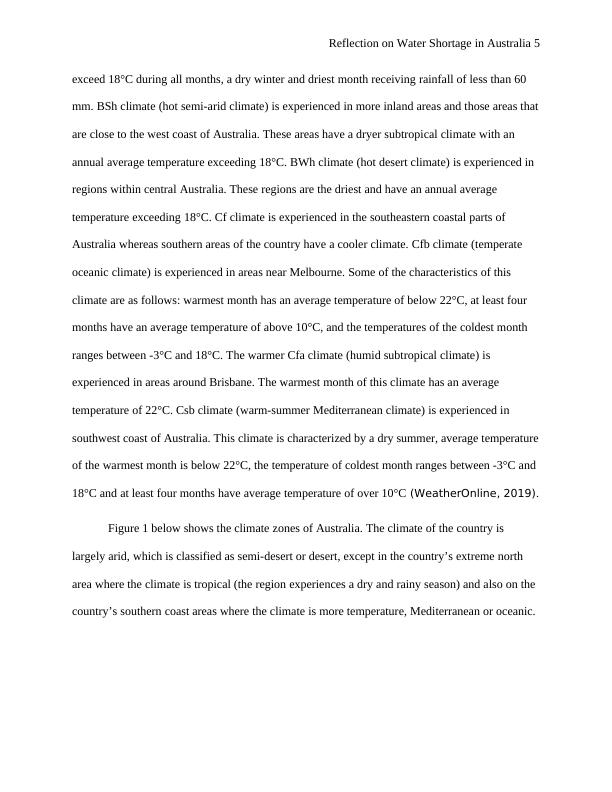
Reflection on Water Shortage in Australia 6
Figure 1: Climate zones of Australia (Go Study Australia Pty Ltd, 2019)
As presented in Figure 2 below, Australia receives less precipitation.
Figure 2: Precipitation of Australia (Climatestotravel.com, 2019)
Tropical climate is non-arid climate with all twelve months having mean temperatures of
above 18°C. Subtropical climate is cool-mild winters and hot-humid summers with evenly
Figure 1: Climate zones of Australia (Go Study Australia Pty Ltd, 2019)
As presented in Figure 2 below, Australia receives less precipitation.
Figure 2: Precipitation of Australia (Climatestotravel.com, 2019)
Tropical climate is non-arid climate with all twelve months having mean temperatures of
above 18°C. Subtropical climate is cool-mild winters and hot-humid summers with evenly

End of preview
Want to access all the pages? Upload your documents or become a member.
Related Documents
Design of a Water Supply System for Mudgee in New South Wales, Australialg...
|21
|4217
|190
Rainwater Harvesting in Sydney, Australialg...
|41
|14377
|97
Civil Engineering Case Study 2022lg...
|23
|5206
|22
Research Methods for Engineers Assignmentlg...
|26
|7441
|25
Engineers Skills and Transportationlg...
|20
|5029
|29
The Historical Impact of Engineering on Society and Engineering Professionalism and Ethics in the Australian Contextslg...
|4
|1249
|289
